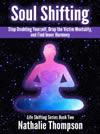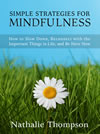 In a previous post, I talked about the process of visualization and gave you six tips for using this powerful process effectively. Today, I want to talk a bit more about why visualization works the way it does and tell you about the history and science behind it, because I’m one of those people who finds it a lot easier to “get” this stuff when I can see actual evidence for it, and I suspect a lot of you are like that, too.
In a previous post, I talked about the process of visualization and gave you six tips for using this powerful process effectively. Today, I want to talk a bit more about why visualization works the way it does and tell you about the history and science behind it, because I’m one of those people who finds it a lot easier to “get” this stuff when I can see actual evidence for it, and I suspect a lot of you are like that, too.
The History of Visualization
Visualization is not a new technique – technically, visualization is a form of meditation, and meditation has been around for thousands of years. The earliest known references to meditation date back to about 1500 BC, and are found in the Hindu Vedas of ancient India, however, meditative practices are found within most religious and spiritual practices throughout history. Traditionally, meditation was used to aid in spiritual development. In more modern times, meditation has been used in a variety of ways to aid in both physical and emotional healing and stress relief.
Visualization meditation, or creative visualization as it is sometimes known, became popular in the Western world after Charles Garfield, author of Peak Performance, brought to light the fact the Russian athletes in the 1980 Olympics spent as much as 75% of their training in mental, rather than physical training! According to this newspaper interview I found, Garfield, who had been doing research to try and determine why some terminal cancer patients overcame the odds and survived, was approached by Russian scientists studying how certain mental states affect physical performance after he delivered a paper at an international cancer symposium in Italy.
In Peak Performance, Garfield references a study done by the Soviets wherein they compared several groups of Olympic athletes and found that the group that spent 50% of their time doing physical training and 50% of their time mentally training performed better than the group that spent 100% of their time training. For a practical example, this would mean that someone who wanted to improve their running speed and planned to practice running four days a week would actually get better results by running twice a week and visualizing themselves running the other two days. This, obviously, was a huge deal that has had a huge impact on how top athletes are trained ever since.
What the Olympic Athlete Study Means
The Russian study and others like it show us how powerful our minds and our mental efforts can be when it comes to physical endeavours. What’s more, this type of visualization-powered success is not just limited to the sports arena; visualization can be used to help you succeed in any area of your life, with any goal or dream you have.
You know from your own personal life experience that when you feel confident about what you’re doing, everything just feels easier, and you’re far more likely to be successful. There’s a kind of flow that you get into and everything just kind of “happens”. Visualization helps to build this feeling of confidence. More importantly, with a regular practice of daily visualization, you convince your subconscious mind that you’ve already done this before – which makes the physical manifestation of what you’ve been visualizing almost inevitable.
Here’s why visualization works the way it does
Which is all well and good, but what’s actually happening here that can tell us why visualization works? There are actually two things that are happening when you visualize:
1) you’re building up your feelings of confidence, because as you’re imagining the success outcome of your goal, that feeling of success becomes familiar to you – so it’s almost like it becomes a given thing that it’ll work out;
and, far more interestingly,
2) your mind does not distinguish between the imagined and the physical – when you are visualizing doing a physical action, all the same pathways in your brain that would be involved in the actual physical doing of the action are still fired up when you’re “just” visualizing yourself doing the physical activity.
Case in point: a 1998 study published in the European Journal of Applied Physiology and Occupational Physiology that looked at volleyball players found that the players who used mental imagery performed better than those who did not; moreover, the researchers in this study also took biometric readings of the players involved in the study and determined that:
[T]he same autonomic channels seemed to be used during the actual activity and during the mental imagery of this activity… [thus] it can be suggested that that… mental rehearsing may help in the construction of schema which can be reproduced, without thinking, in actual practice.
Essentially, using visualization to help prepare for a task actually has the effect of you practicing the actual doing of that task. Your mental rehearsal has the same effect as the physical rehearsal would have had, and your mind is creating a pattern, or script, that it then follows automatically when you go out an actually perform the task you’ve been visualizing! How cool is that?! 🙂
So, visualization works, and real science has proven these effects over and over again. I was able to find quite a number of studies supporting the effectiveness of visualization techniques in improving physical performance, all of which were published in peer-reviewed scientific journals. Which made me very happy – some things you just know, but it’s always nice to have the evidence to back it up and show us exactly how and why visualization works the way it does!
photo credit: (c) Can Stock Photo

















How fabulous! We can actually create our own reality this way. Through the preview of the visualization.
I especially liked the last two paragraphs. How about if bad thoughts creep in, though? Is this just due to lazy focus or is a reflection of our fears? These are indicators of things we need to clean up perhaps. For example, one can visualize the perfect job, but thoughts creep in that it is too good to be true and that it does not exist. But the point is, since you visualized it, it is totally possible and you are setting yourself up this way to not make it happen due to this limiting belief.
So, just sticking to what we want and feeling good about it should do wonders. I know it has for me! Thank you!
It’s a reflection of your fears. When thoughts like “it’s too good to be true” creep in, it’s a reflection of all the programming you’ve been subjected to throughout your life. All that training that told you to be careful what you wish for, that nothing is ever as good as it seems, and that dreams don’t come true. And I’ll bet that as you read those lines, you could feel the awful twisting feeling inside you. This feeling is telling you that these words are untruth. You know this. These thoughts are just shadows… monsters under the bed caused by our fears. They are not real, and when we cast a light into those dark corners, we can see them for what they are.
When you find these kinds of bad feeling thoughts cropping up, try this: pause. Realize that it’s just a shadow thought. Imagine yourself shining a light onto the thought and seeing it fade away. Alternatively, try personifying the thought: see the thought as a little gremlin… a pain, but kind of cute in its own way, like an obstinate little kid having a tantrum or something. Pat the little gremlin-thought on the head, tell it how cute it is, then turn away, shake your head at how little it knows, remind yourself that it, too, will get there in its own time. And then refocus yourself on your goal. These are both useful techniques for disolving or evaporating the power these types of negative thoughts have over you.
Thanks for this. It is helpful. Worry should be eliminated from our life, period. It just does not serve us. It only keeps us back, wastes energy and does not do anything. Things happen without it.
I have been analyzing it more and understand it better, but can’t help myself. I am used to worrying. It is part of the process and when I care about something, I worry about it, even though I know I shouldn’t. It is a very bad habit I am trying to eliminate. 🙂
You’re very welcome, and I do agree — worrying is one of those things we should all just drop from our lives. It doesn’t help anything, and just makes us feel worse. But “just dropping it” is easier said than done, especially when it is something we care about. But we can work on it, and try to shift out of that mode when we realize we’ve fallen into it.
The Dalai Lama has a great quote about worrying that I find helps put this into perspective:
Nathalie,
Thanks for sharing the great article. I enjoyed your thoughts on why visualization assists with creating alignment =)
Namaste
Thanks Namaste — glad you enjoyed the article. 🙂